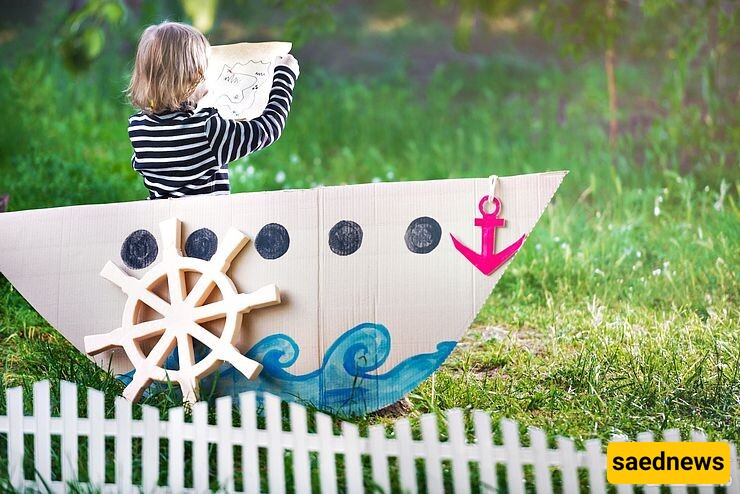The power of imagination and daydreaming in children helps them learn skills and improve their memory. Join us in this article as we explore the topic of daydreaming in children.

A child’s imagination is the most important factor in their personality development and communication skills. Through their imagination, children express their thoughts and interpret the world in their own way. Parents must be highly attentive in this regard, ensuring that their child's imagination is neither suppressed nor allowed to become uncontrollable, as both extremes can harm the child. Daydreaming should remain balanced, and parents should guide their children’s development through proper engagement with their imaginative thoughts. It is advisable to consult a child psychologist or counselor to learn how to manage a child's daydreaming effectively.

Children’s imagination consists of thoughts and mental images that do not exist in reality but are part of their inner world. In child psychology, imagination is considered a gateway to understanding a child’s mind. Children use their imagination to communicate their thoughts and feelings. These imagined scenarios have no external representation in the real world. For example, a child might imagine a unicorn sleeping in their bed at night, which is their way of expressing certain emotions or ideas.

Relying too much on imagination can distance a child from reality. While imagination and dreams are beneficial as long as they do not negatively impact the child, excessive daydreaming can cause issues such as sleep disturbances, bedwetting, fear, insecurity, social isolation, and disrupted relationships. If these issues arise, parents should seek help from a child psychologist.
Having an active imagination and even imaginary friends has many benefits, such as fostering creativity and improving social skills in adulthood. However, if an imaginary friend becomes a child’s only companion, parents should be concerned. Parents should help children distinguish between reality and fantasy while also encouraging creative thinking in a controlled manner.
Several factors affect the extent and nature of a child’s imagination, including:
Genetics: Creativity and imagination can be inherited from parents or relatives. Parents should identify and nurture their child’s creative abilities.
Environment: A child's surroundings play a crucial role in shaping their imagination. School, play areas, peer groups, family, and social interactions can either encourage or suppress creativity. Parents should ensure that their child’s imagination is guided in a healthy direction without causing psychological stress.
Ages 1 to 3: It is difficult to determine exactly when a child starts daydreaming. Even before the age of three, children create their own imaginary worlds where they envision victories and defeats. By age three, children’s imagination becomes more evident as they begin to see themselves as independent individuals. At this stage, they may struggle to differentiate between reality and fantasy, often making statements that may sound like lies to adults.
Ages 3 to 7: At this stage, children still lack a full understanding of reality. Between ages 4 and 7, daydreaming often peaks, and some children may begin to create elaborate stories.
Adolescence and Puberty: In teenage years, imagination plays a key role in shaping future aspirations. Some teenagers rely heavily on daydreaming to escape challenges, and excessive fantasy can detach them from reality. In some cases, storytelling and fictional narratives influence their perception of life.
Children may rely on their imagination for various reasons, such as:
When their real world is too harsh or unpleasant.
When they lack necessities like food, love, protection, or security.
When they feel extreme anger and find no solution.
When they seek superiority and chase pleasurable mental scenarios.
When fear, anxiety, or inner conflict overwhelms them.
When they experience abuse or mistreatment and see no escape.
When they struggle to meet expectations or achieve their desires naturally.
When they witness constant conflict between parents and feel unsafe.
When they have no playmates and grow up in isolation.
When they develop psychological imbalances that disrupt their sense of reality.
Albert Einstein famously said, “Imagination is more important than knowledge.” A child’s imagination provides insight into their inner world. Through their fantasies, they express their thoughts, concerns, and emotions. A healthy imagination indicates an active and developing brain. However, if left unchecked, excessive fantasy can be harmful.

The most common sign of an active imagination in children is having an imaginary friend. To understand your child’s imaginative world, pay attention to:
Their Questions: Children may ask unexpected questions about topics like the universe, God, birth, or the meaning of life. These inquiries often reflect their imaginative thinking.
Dreams: Children’s nighttime dreams offer clues about their thought processes. Since young children struggle to differentiate between reality and dreams, parents should help them understand that dreams are not real.
Drawings: A child’s artwork provides a window into their imagination. Sometimes, they depict things they have never seen before. Parents should encourage their child’s creativity and discuss their drawings with them.
Playtime: Children often speak their thoughts aloud while playing. They may create stories and act them out with toys. A well-structured play environment supports healthy imaginative development.
Reasoning: When questioned, children’s explanations may sound humorous or illogical to adults. This does not mean they are lying; rather, they perceive reality differently. Their justifications can indicate the extent of their imagination.
Parents should create an environment that nurtures a child’s creativity. Imaginative thinking is limitless, and it is the parents’ responsibility to balance encouragement with structure. Suppressing a child's imagination too much can hinder their development, while excessive indulgence can cause them to lose touch with reality.
After watching cartoons, children often identify with characters and imagine possessing their exaggerated traits. This is normal and helps cognitive development, but excessive attachment to fictional characters can be harmful. Children who spend excessive time watching cartoons or playing video games may experience negative effects. Parents should regulate screen time and encourage group play to maintain a balanced imagination.
Both boys and girls engage in imaginative thinking, but their fantasies often reflect gender-specific themes. Research suggests that:
Girls tend to imagine magical worlds focused on beauty and creation.
Boys often fantasize about extraordinary powers and heroic achievements.
Despite common concerns, imagination offers several advantages:
It provides an outlet for desires and emotions.
It can bring comfort and joy by allowing children to envision success.
It helps reduce anxiety by offering a mental escape.
It fosters creativity, leading some children to become writers or artists.
It aids in overcoming psychological conflicts.
It serves as a coping mechanism during difficult times.
When your child shares their imaginative thoughts, listen attentively and engage with their ideas. Encouraging storytelling and drawing can help children express themselves creatively. Never dismiss their imagination as lies or scold them for it. Children under the age of five do not distinguish between truth and fantasy in the way adults do.
If daydreaming becomes excessive and interferes with daily life, consider these approaches:
Teach them self-control by emphasizing their ability to manage their thoughts.
Encourage mindful breathing exercises to reduce excessive daydreaming.
Adjust their learning environment to increase focus.
Avoid forcing them to stop daydreaming completely—help them channel it productively.
Ensure a healthy diet and adequate sleep, as both influence concentration.
While daydreaming is natural and beneficial, excessive or obsessive fantasy can isolate a child from reality. If your child spends most of their time in their imaginary world and avoids social interactions, consulting a child psychologist may be necessary.

